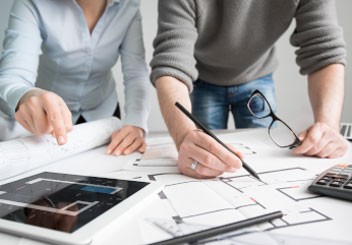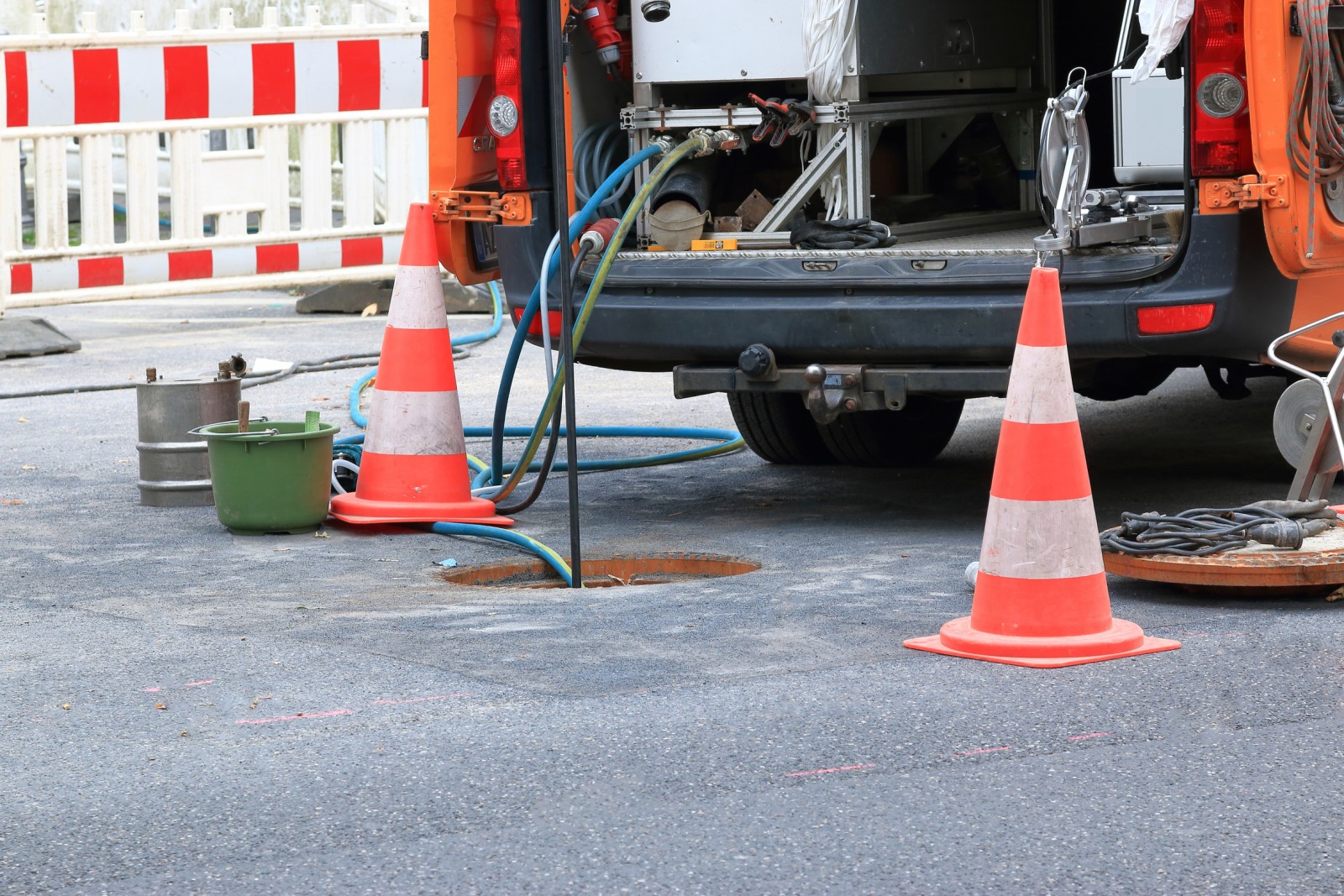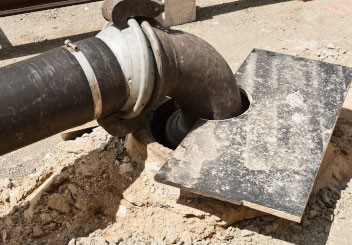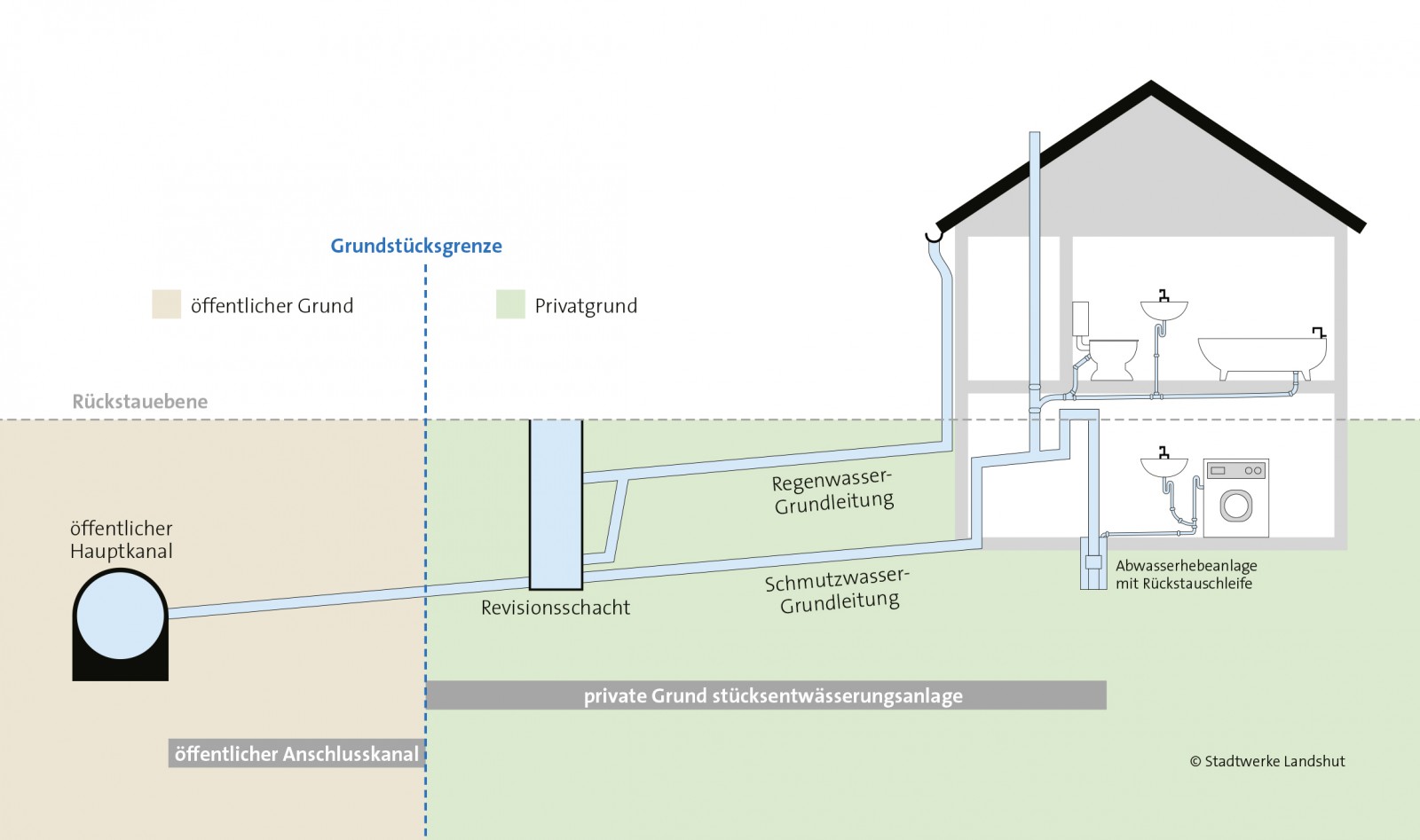Site drainage
On this page you will find everything about the topics »Land drainageand »Sewer connection, »Check house connection, »Protection against backwater and »Introduction of groundwater.
Land drainage and sewer connection
Proper disposal of dirt and rainwater is a matter of course for many. However, responsibility is not limited to public wastewater disposal. Every single landowner is required here.
The wastewater of a building is fed via the so-called land drainage system (GEA) to the public sewer. The property owner is responsible for the construction and maintenance of this facility. The accumulating rainwater is to be seeped into the new development - as far as technically possible - on the property.
The planning and production of the drainage system must be carried out in accordance with the currently valid EN and DIN standards as well as the generally recognized state-of-the-art rules.
A land drainage system consists of the underground pipes, inspection shafts and the sewer pipes. Work on these lines may only be carried out and checked by specialist companies. The "transfer" of the wastewater is usually at the property boundary.
Builders and planners get under information builders additional suggestions and useful tips for the planning and production of the property connection and the land drainage system. This should help you to avoid any errors and later annoyance during operation by the landowner or at the acceptance by the public utilities.
Proof of freedom from defects
Please remember at an early stage that you promptly inform the public utilities for the final acceptance with the implementation of a water level test when rebuilding, expanding or reconstructing the site drainage system to check the tightness of the buried sewage pipes for rain, dirt and mixed sewers. As a rule, existing systems must be checked every 25 years.
The legal basis for the construction, operation and maintenance of the land drainage system is the Drainage Ordinance (EWS) of the City of Landshut. As property owner you are obliged to comply with the drainage statute.

Checking the canal house connection
The network of public canals in the city of Landshut must be regularly maintained and repaired in the event of damage like any other building. The municipal utilities regularly check the main and connecting canals in the public road area to see if they are tight.
Property owners must also have their own drainage pipes in the ground regularly checked for damage, for example via a camera inspection. Irrespective of the stipulated deadlines in the drainage statute of the city of Landshut, you should ensure in your own interest the lasting functioning of your drainage system. As with the car or the heater, it usually only gets really expensive if damage is detected too late or an emergency situation has occurred.
And: Functional lines serve both environmental and water protection as well as the value preservation of your property.
" Continue reading
At the latest, if Stadtwerke Landshut checks the public sewer main lines and property connections as part of the self-monitoring, you must expect that the Stadtwerke demand proof of the absence of defects in your property drainage system.
Our tip: Ask Stadtwerke Landshut if the municipal sewers in the connection area will be checked in the near future or if sewer or road construction measures are planned. You may receive a favorable offer for your own commission from the companies commissioned by Stadtwerke, which are already working on site anyway. You will find more tips in our guide to checking the canal house connection.

Frequently Asked Questions (FAQ) & Info
Grundstücksentwässerungsanlagen sind bauliche Anlagen in Gebäuden und auf Grundstücken, mit denen Schmutz- und Regenwasser gesammelt, bei Bedarf behandelt und abgeleitet wird. Dazu gehören die Abwasserleitungen im Gebäude und die sogenannten Grundleitungen, die im Erdreich oder unter dem Haus verlegt sind. Auch Revisionsschächte sowie Anlagen wie Rückstauverschlüsse und Abwasserhebeanlagen gehören dazu. Sollte sich auf Ihrem Grundstück kein Revisionsschacht befinden, so ist dieser nach § 9 Abs. 4 EWS am Ende der Grundstücksentwässerungsanlage in unmittelbarer Nähe der Grundstücksgrenze zu errichten.
Der Grundstückseigentümer ist bis zur Grundstücksgrenze für Bau, Betrieb, Unterhalt, Wartung und Instandsetzung der Grundstücksentwässerungsanlage auf seinem Privatgrund zuständig. Der Kanalnetzbetreiber (Stadtwerke Landshut) ist für die Anschlussleitungen und Sammelkanäle auf öffentlichem Straßengrund zuständig.
Leaky pipes, which are above the groundwater level, lead to soil and groundwater contamination due to escaping sewage. In leaking pipes, which are below the groundwater level, groundwater penetrates into the sewers as so-called "extraneous water" and has the consequence that the sewers are polluted or overloaded by larger amounts of sewage, rainwater overflows more quickly, the sewage treatment works with lower efficiency and higher operating costs attack. Damage in pipes can also lead to flooding of cellars due to blockage.
Der Dichtheitsnachweis kann grundsätzlich über eine Druckprüfung oder eine Kamerabefahrung (optische Prüfung) erfolgen. Die Vorteile einer Druckprüfung liegen in der einfachen Durchführbarkeit, insbesondere bei schwer zugänglichen, stark verzweigten Leitungen. Außerdem können mit einer Druckprüfung auch optisch nicht sichtbare Undichtigkeiten wie fehlende Dichtungsringe nachgewiesen werden. Sollte die Druckprüfung allerdings negativ ausfallen, ist zur Lokalisation der Schadstellen oft trotzdem eine Kamerabefahrung notwendig. Zusätzlich können mit der optischen Prüfung die Lage und der Verlauf der Leitungen Ihrer GEA lokalisiert und auf dem Entwässerungsplan angepasst werden.
Bei der Druckprüfung mit dem Medium Wasser wird der zu prüfende Leitungsabschnitt abgesperrt und mit Wasser befüllt. Während der Prüfung wird der Wasserverlust gemessen und das Ergebnis mit Grenzwerten verglichen. Nach einer nicht bestandenen Prüfung muss die Schadstelle lokalisiert werden. Dies kann durch Prüfung kleinerer Leitungsabschnitte oder per Kamerabefahrung erfolgen.
Bei der optischen Prüfung wird eine Kanalkamera über den Revisionsschacht, eine Revisionsöffnung im Haus oder vom öffentlichen Kanal über den Grundstücksanschlusskanal in die Leitungen eingeführt. Speziell ausgerüstete Kameras können auch in weitere Abzweige vorgeschoben werden. Die optische Prüfung ist in der Regel für eine
Überprüfung der Dichtheit ausreichend („optische Dichtheit“).
Vor der Prüfung sollte der Entwässerungsplan des Grundstücks kontrolliert werden. Wenn er nicht mehr aktuell ist oder wichtige Angaben fehlen, sollte er anhand der Kamerabefahrung aktualisiert werden. Fehlt der Entwässerungsplan ganz, ist ein neuer anzufertigen. In beiden Fällen ist er den Stadtwerken Landshut vorzulegen.
In der Entwässerungssatzung (EWS) der Stadt Landshut ist in § 12 die laufende Überwachung der Grundstücksentwässerungsanlage geregelt. Bei Neuerstellung, Erweiterung oder Umbau der Grundstücksentwässerungsanlage (gemäß eines vorher zur Prüfung und Genehmigung einzureichenden Entwässerungsplanes nach § 10 EWS) sind zur Überprüfung der Dichtheit der im Erdboden verlegten Kanalleitungen für Regen-, Schmutz- und Mischwasserkanäle umgehend die Stadtwerke Landshut für die Endabnahme mit Durchführung einer Wasserstandsprüfung zu verständigen.
Bei der laufenden Überwachung älterer Grundstücksentwässerungsanlagen hat der Grundstückseigentümer die von ihm zu unterhaltenden Anlagen in Abständen von jeweils 25 Jahren ab Inbetriebnahme auf eigene Kosten durch einen fachlich geeigneten Unternehmer auf Mängelfreiheit zu prüfen und das Ergebnis durch diesen bestätigen zu lassen. In Wasserschutzgebieten gelten gegebenenfalls kürzere Prüfungsintervalle.
Generell gilt: Je früher man sich mit dem Thema beschäftigt, desto geringer ist der Handlungsdruck und entsprechend höher die Chance, eine kostengünstige Lösung zu erreichen. Spätestens wenn die Stadtwerke Landshut die öffentlichen Kanäle und Grundstücksanschlüsse im Rahmen der Eigenüberwachung überprüfen, müssen Sie damit rechnen, dass die Stadtwerke den Nachweis der Mängelfreiheit Ihrer Grundstücksentwässerungsanlage fordern. Die Eigentümer erhalten bei entsprechender Aufforderung ein Schreiben von den Stadtwerken.
The property owners must organize and finance the rehabilitation of the land drainage system. You can choose either a refurbishment company, which also takes over the redevelopment planning or have the refurbishment measures planned and monitored by an independent specialist office, in order to select a technically meaningful and economical procedure with regard to the large number of refurbishment possibilities. The employees of Stadtwerke Landshut are happy to advise you on basic questions, but do not create any renovation concepts.
Die Sanierung ist durch die beauftragten Firmen zu dokumentieren. Nach Abschluss der Sanierungsarbeiten muss die sanierte Abwasseranlage erneut auf Dichtheit geprüft und das Ergebnis dokumentiert werden. Wir empfehlen Ihnen außerdem, mit der ausführenden Firma eine Gewährleistungsfrist von mindestens fünf Jahren und eine erneute Dichtheitsprüfung vor Fristablauf zu vereinbaren.
Die Sanierung der festgestellten Schäden in den Rohrleitungen erfolgt entweder in offener Bauweise durch Aufgraben und Erneuerung der defekten Leitungen oder grabenlos durch Einzug einer Leitung in ein bestehendes schadhaftes Rohr (sogenannter Schlauchliner). Auch bei der Schachtsanierung besteht die Möglichkeit der Erneuerung in offener Bauweise oder mit Auskleidungs-, Beschichtungs- oder Abdichtmaßnahmen.
Welche Sanierungsart die beste für Ihre Grundstücksentwässerungsanlage ist, hängt von vielen Faktoren ab, unter anderem an der Anzahl und Art der Schäden, dem Zustand der Rohre und Muffen, der Zugänglichkeit der Leitungen und der Anzahl der Abzweigungen. Manchmal kann es auch sinnvoll sein, die Grundstücksentwässerungsanlage neu zu planen und nicht mehr benötigte Leitungen stillzulegen, Leitungen zusammenzulegen oder Regenwasser auf dem Grundstück zu versickern.
Die Kosten hängen stark von den jeweiligen Gegebenheiten (z. B. Leitungslängen, Zugänglichkeit, Schadensart und -umfang) ab. Als groben Anhaltswert für ein normales Grundstück mit Wohnhaus kann man zwischen 700 und 1.500 Euro für die Reinigung und Inspektion sowie 1.000 bis 10.000 Euro für die Sanierung rechnen. Durch Sammelaufträge für mehrere benachbarte Grundstücke können oft erhebliche Kosteneinsparungen erzielt werden. Diese Angaben sind ohne Gewähr.
With the following tips we would like to help you to find the right partner for your project:
- Companies can be found in the local business directory (for example, "Yellow Pages") or Internet search engines under the keywords "Kanal Landshut" or "Kanalsanierung Landshut", etc.
- We recommend that you obtain an offer from several companies.
- For all work around the private sewers only specialist companies should be commissioned. Qualified professionals and companies can be identified, for example, by certificates and quality marks from DWA, ICT, TAH, VSB, RSV or RAL quality assurance.
Weitere Informationen sind auch auf der Internetseite des Bayerischen Landesamts für Umwelt available.
Protection against backwater
Basements are threatened with a particular unwelcome form of moisture against which it has to be secured: a backwater from the public sewer system. This can happen, for example, during heavy rain or when the public sewer system becomes blocked. In the event of backwater, for example, wastewater can penetrate into basements via wash basins, washing machines, floor drains or toilets and cause damage.
Owners can protect themselves through a backwater protection. The drainage statute of the city of Landshut provides homeowners with such a safeguard in § 9 (6): "Against the backwater of the wastewater from the drainage device, each subscriber has to protect itself. Unless otherwise specified by the city for the individual case, the road level at the junction shall be assumed to be the backflow level. "
For example, a wastewater lifting plant can help. Lifting systems collect the wastewater that accumulates under the backflow level in appropriate storage containers and then pump it via the backflow loop into the sewer system. Easier backflow stops interrupt the flow in backflow-prone sewers through valves, gate valves or pinch valves.
Experts, who should always be consulted for the installation of such fuses, advise mostly to sewage lifting equipment. Because only with her the house drainage in the basement rooms remains fully operational. The backup against backwater is only effective if they are regularly maintained. Homeowners have to expect a backwater, even if it has not come to that. Sanitary installers are the right contact person and are happy to clarify.
Further information on this subject can be found in the flyer "Protection against backwater".
Introduction of groundwater
For construction projects in the groundwater area or for pumping tests on private land, it may be necessary to build up or discharge discharged groundwater into the public sewer system if there is no possibility of seepage (eg no suitable infiltration areas or contaminated groundwater prevails) or other diversion (eg, inflow into a body of water).
Eine Genehmigung zur Einleitung von Grundwasser in die öffentliche Kanalisation ist bei den Stadtwerken Landshut, Bereich Abwasser, zu beantragen. Bitte reichen Sie dazu per E-Mail an abwasserbeseitigung@stadtwerke-landshut.de einen Lageplanauszug mit Darstellung der Lage der vorgesehenen Bauwasserhaltung bzw. den Brunnenbohrungen ein und geben Sie bitte die voraussichtliche Einleitungsmenge und den vorgesehenen Pumpenzeitraum zur Beurteilung an.
Vorbehaltlich einer wasserrechtlichen Erlaubnis gem. § 2 Abs. 1 Wasserhaushaltsgesetz erhalten Sie nach Prüfung der Unterlagen im Regelfall eine „Sondervereinbarung über ein Benutzungsverhältnis nach § 7 der Satzung für die öffentliche Entwässerungseinrichtung der Stadt Landshut“ in zweifacher Ausführung, die Sie unterzeichnet an die Stadtwerke Landshut, Abwasser, zurücksenden. Eine Ausfertigung erhalten Sie als Antragsteller nach Unterzeichnung durch die Stadtwerke Landshut wieder zurück.
" Continue reading
Wichtig, für Sie zu beachten:
- The necessary measures in the public traffic area for securing the drain line and the discharge shaft must be initiated by you as the applicant. In addition, all other provisions of other relevant departments must be observed.
- Der Beginn und das Ende der Wasserhaltung sowie alle Störungen und Unterbrechungen sind beim Bereich Abwasser der Stadtwerke Landshut zu melden.
- The amount of water must be measured by a water meter or other suitable measuring device. In the case of a raiding unit, the raid heights are to be measured every two hours during the day and entered in a list that must be sent to the public utilities after completion.
- Vor Einleitung in den Kanal ist das Wasser über eine Absetzvorrichtung zu entsanden. Ablagerungen im öffentlichen Kanal, die durch die Einleitung entstanden sind, werden auf Kosten des Antragstellers beseitigt.
If you have further questions about discharging groundwater, you can call 0871 1436 2502 or send an e-mail to abwasserbeseitigung@stadtwerke-landshut.de turn.

Haben Sie Fragen zur Einleitung von Grundwasser?
Contact
Phone: 0871 1436-2502
E-mail: abwasserbeseitigung@stadtwerke-landshut.de


